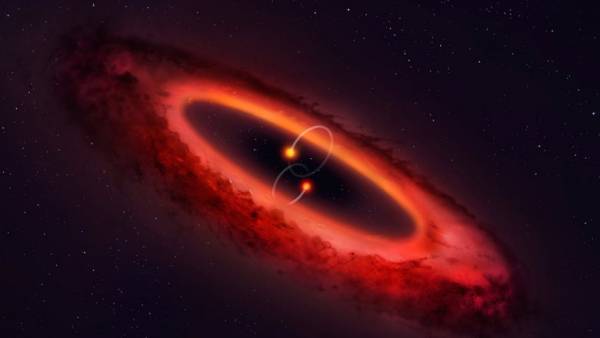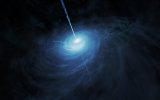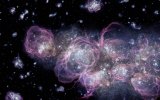Open the anomalous system in which four stars
Sometimes in a star system there is not one, but two stars. In exceptional cases, three. And now astronomers have discovered a strange system with four stars and the unusual protoplanetary disk.
Upstairs
In our own Solar system has only one star and a handful of planets. However, in space there are other, more complex star systems with two or — much more rarely — even with three stars that revolve around each other in complex orbits. However, the new discovery has proved that this is not the limit: the team of astronomers was able to find in the Universe a system with four stars. Surprisingly, but all the time she “hid” in total, 146 light years from us!
The news Found the brightest object in the Universe
Found the brightest object in the Universe
System called HD 98800 was discovered by astronomers using Large millimeter array Atacama, a giant radio telescope, located in Chile. The radio telescope was the key to opening this system, because the stars were surrounded by a protoplanetary disk — the ring of gas and dust from which in the future will form a new planet. But until then, this ring absorbs much of the light coming from the system — that’s why she remained hidden for so long.
But where there is light, permeate the radio waves. With the radio telescope, scientists were able to detect four separate star, inside the dust cloud. They form two pairs — one right in the center of the system and the other on the first orbit (about a trillion kilometers). The outer pair of stars called Aa and Ab, and the stars internal — Ba and Bb.
The system itself is a unique phenomenon, but even more unusual it makes the protoplanetary disk. In most systems it is aligned relative to the primary star.News string Theory helped to explain dark energy
string Theory helped to explain dark energy
For example, in the Solar system all the planets and most asteroids rotate approximately in the same plane with the Sun. But for HD 98800 is not the case — it has a gas-dust disk is located at a right angle relative to the Central stars. This is the first of the known systems, with a perpendicular disk — like anomaly promises many amazing discoveries. Perhaps if astronomers can detect and others are “older”, it will be possible to observe planets revolving in odd orbits from all angles. In turn, this can lead to the formation of a new, still unknown to the science types of planets.
However, there is another scenario: in such conditions of the protoplanetary disk simply will not be able to form planets. Remains to continue the search — in space is still a lot of strange things unknown to mankind.
 NICOLAS LEFAUDEUX1/11
NICOLAS LEFAUDEUX1/11
Equipment: Camera Nikon D810 Lens AF S NIKKOR 105mm, tripod, ISO 64, exposure — of 0.3, 0.6 and 1.3 seconds.
Nicolas Lefto — optical engineer, physicist and mathematician. According to him, his first camera was a Soviet “Zenit”. In his work he uses an automated set of cameras that shoot in accordance with the created algorithm.
Your the sun of the jury recognized the best in this category he called “the sun King, a little king, and God of war.”
 STEVEN MOHR2/11
STEVEN MOHR2/11
Equipment: Telescope PlaneWave CDK 12.5, with filters Astrodon Gen II LRGB, Ha lens Baarder 2541 mm, tripod Astro Physics 900, camera SBIG STXL-11000.
Stephen Moore also enjoys to shoot complex automated system of two telescopes — one is for aiming, the other for the actual shooting. The system used by Moore, worth several thousand dollars.
Mor this year won in the nomination “the Shooting of the galaxy” with a photograph titled “the Mysterious galaxy”.
 BRAD GOLDPAINT3/11
BRAD GOLDPAINT3/11
Equipment: camera Nikon D810 lens 14 mm f/4.0, ISO 2500, Shutter speed — 20 seconds.
The winning in the category “People and space” and has taken the Grand Prix, author brad Goldplat called “Movement soul.”
Goldplat is a professional photographer who shoots wildlife and the night sky. He also makes videoaudio in an accelerated time, which can be viewed on his website.
 JORDI DELPEIX BORRELL4/11
JORDI DELPEIX BORRELL4/11
Equipment: telescope Celestron C-14, tripod Sky-Watcher NEQ6 Pro camera ZWO ASI 224MC, 4200 mm f/12, shutter speed — 2-milliseconds.
The boundary between the moon’s Sea of tranquility and the Sea clear with inverted colors — the best photo of the moon this year. It took the Spaniard Jordi, Delphi, Borrell from Barcelona. Borelli, not for the first time wins the competition: she took the award for best photo of the moon last year.
 NICOLAS LEFAUDEU5/11
NICOLAS LEFAUDEU5/11
Equipment: camera Sony ILCE-7S2, lens 20 mm f/1.4, shutter speed — 3.2 seconds.
In the category “best picture of the Northern lights” won our friend Nicolas Lefto. He used a relatively long exposure to create the effect of “traffic star highway” towards Aurora.
 MARIO COGO6/11
MARIO COGO6/11
Equipment: telescope Takahashi FSQ 106 ED, tripod Astro-Physics 1200 GTO camera Canon EOS 6D Cooling Mod CDS, 530 mm f/5, ISO 1600, total exposure to six hours.
The called “the Dust of the southern crown” Mario is one of the Italian city of Palladio. 58-year-old Who writes bought his first camera at the age of 16, and immediately started to shoot the stars. Almost all of my photo shoots Who in the area of lake Braies in the North of Italy.
 FERENC SZÉMÁR7/11
FERENC SZÉMÁR7/11
Equipment: Camera Sony SLT-A99V DSLR, a Minolta 80-200 lens 135mm, exposure time of 300 seconds (X50) .
In this photo, in pastel colours depict the movement of Alamak — the third brightest star in the constellation of Andromeda — in the sky. Hungarian Ferenc Zemar took it off in February. The won in the category of “heavenly landscape”.
 CHRIS BRAMLEY8/11
CHRIS BRAMLEY8/11
Equipment: Takahashi FSQ106 telescope at 106 mm, a tripod and the Paramount ME mount, camera SBIG STL-11000M, exposure: LRGB: 30 minutes.
Nomination “the lens” — photo taken robotic systems in semi-Autonomous mode. This photograph, taken a prominent astrophotographer and astronomer Daniel Picha with the help of the automated system, captures the constellation of the Pleiades and the passing of the comet him.
 MARTIN LEWIS9/11
MARTIN LEWIS9/11
Equipment: self-assembled reflecting telescope 444 mm, infrared filter Astronomik 807nm IR self-assembled Equatorial platform, camera ZWO ASI174MM extract -5,3 seconds.
“Grace Venus” is the name of the Briton Martin Lewis, a winner in the nomination “the best photo of planet, comet or asteroid”. Planet photos Venus.
 TIANHONG LI10/11
TIANHONG LI10/11
Equipment: NIKON D810A camera, lens 35 mm f/2, exposure time 120 seconds (x4).
The photo with the gloomy title “the Curtain” — the landscape of Inner Mongolia from the radio Observatory designed to study the Sun. The author of the picture — Whether Tianhong.
 FABIAN DALPIAZ11/11
FABIAN DALPIAZ11/11
Equipment: camera Canon EOS 5D Mark III, lens 50 mm, exposure time — 8 seconds.
Fabian Dalpiaz from the Italian town of Castelrotto, this year, was named best young photographer. In its 16 years, Dalpiaz received prizes in the competition twice, both times in his age category.